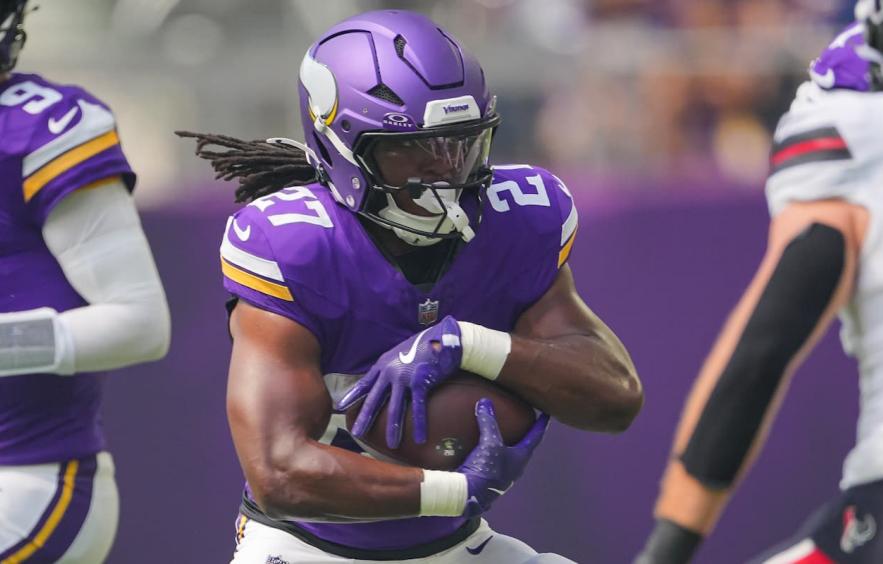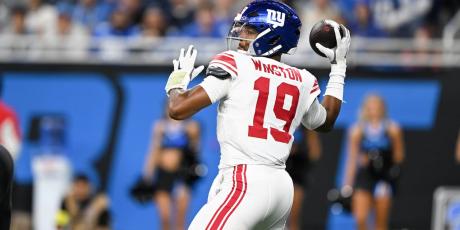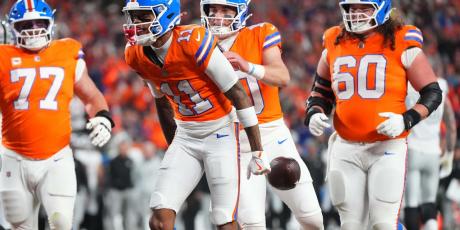4 Fantasy Football Tips You Won't Hear Everywhere Else - 2025 Edition

In the old days, we received our NFL news once a day (at best) from SportsCenter, and gathered our fantasy tips and tricks from a magazine that came out in July ... and never saw a useful update. Those days are gone. Now we receive news the second it breaks and our advice from one of eight gazillion articles or podcasts published all the way up to draft day.
As a result, there's far less that we don't "know" heading into the season.
But we dig deep here at 4for4 ... so I've updated our four nuggets of wisdom that you won't hear everywhere else. Whether spin-offs of more popular advice or outright sleeper tips, these are less mainstream concepts that can (and will) help you win your leagues. And because we first published these tips last summer, I've included a review of how they panned out in 2024.
Optimize the value of slow starters (particularly rookies) with early-year fill-ins
Back in 2015, the St. Louis Rams selected running back Todd Gurley 10th overall, despite the torn ACL he had suffered just five months prior. They eased Gurley into the lineup, sitting him for Weeks 1-2 and giving him just 14 snaps in Week 3 ... before feeding him 248 opportunities the rest of the year. He ended up finishing as the RB7 after being drafted around RB27. Now imagine if you paired Gurley with a solid low-cost back to fill in the gap ... someone like Danny Woodhead (RB40 in ADP), who saw 41 opportunities over those three games. Woodhead's first three weeks plus Gurley's next 12 weeks would have given you 244.5 fantasy points over the full fantasy season — good for RB2 overall.
What's the point of this trip down memory lane? To highlight the value of pairing a slow starter — entering their rookie season, adjusting to a new offense, recovering from injury, etc. — with an inexpensive short-term stop-gap. Last year, we suggested combining Rashee Rice with Brian Thomas Jr. Rice started the season on fire, averaging 17.6 half-PPR fantasy points per game, before injury derailed his year. Meanwhile, Brian Thomas Jr. started a little slow — 10.1 PPG through three weeks — before going absolutely nuclear down the stretch. If you played Rice for his three healthy weeks and then slotted in BTJ, your resulting "combo WR" scored 263 fantasy points ... which would have been WR2 overall, just behind Ja'Marr Chase.
Other rookies we highlighted for "slow starts" but strong finishes included pass-catchers Malik Nabers, Ladd McConkey, and Brock Bowers, as well as quarterback Jayden Daniels. If you drafted any of those guys, you probably had a decent year.
So who do we like for 2025? Here are a few ideas at every position ...
- RBs Cam Skattebo, RJ Harvey, and TreVeyon Henderson (rookies) OR
- Jordan Mason and Braelon Allen (potential late-season job-winners) with ...
- The veteran back in each of those backfields, ideally NOT paired with their teammate (so you get maximum upside): Tyrone Tracy, J.K. Dobbins, Rhamondre Stevenson, Aaron Jones, Breece Hall
- Veterans who might lose steam or battle injury later in the year: Alvin Kamara, James Conner
- WRs Tetairoa McMillan, Travis Hunter, Emeka Egbuka, Matthew Golden, Jayden Higgins, Tre' Harris, Kyle Williams, and Rome Odunze (rookies/youngsters) OR
- Terry McLaurin (holdout), Rashee Rice (looming suspension), Jordan Addison (suspension), Chris Godwin (injury) OR
- DK Metcalf, George Pickens, Calvin Ridley, Deebo Samuel, Josh Downs (new QBs/offenses) with ...
- Xavier Worthy (if Rice suspension comes through early)
- Mike Evans (only healthy veteran)
- Ricky Pearsall (only healthy receiver, period)
- Courtland Sutton (early alpha who could lose targets to youngsters later)
- DeVonta Smith or Jakobi Meyers (always good for several spot starts)
- Chris Olave (healthy for now)
- TEs Tyler Warren and Colston Loveland (rookies) with ...
- Evan Engram (cheap, lots of available targets)
- Mark Andrews (like the DeVonta Smith of TEs)
- Tucker Kraft (might have more early work with WR injuries)
- David Njoku (more trustworthy with Flacco starting)
- QBs Dak Prescott (returning from injury), Justin Fields (new team/offense), Drake Maye (new offense), Caleb Williams (new offense), J.J. McCarthy (basically a rookie), Trevor Lawrence (new offense), Michael Penix (first full year as starter), Bryce Young (breakout potential) with ...
- Brock Purdy, Jared Goff ("ol' reliable" spot-starters)
- Justin Herbert (might carry the offense more early on while RBs get adjusted)
- Jordan Love
The "stacks" phenomenon can be a trap in typical season-long leagues
You may have heard (or even asked) the question: "Should I draft this player if I already have his teammate on my roster?" And now with the rise of best-ball popularity, you may be familiar with the concept of "stacking." But for those who aren't, or who are eager to apply the concept to season-long, set-a-lineup leagues, here's what you need to know.
"Stacking" a quarterback and pass-catcher from the same team is consensus wisdom in best-ball formats (as well as DFS tournaments) due to the value of weekly upside. When one hits big, it's more likely both hit big, raising your potential ceiling — which is all that matters in these formats. But in typical season-long leagues, you are playing against one opponent weekly and need equal parts consistency and upside to win. In these leagues, stacking can be a trap.
For one, it creates pressure to shun ADP to "secure" your stack, which can lead to poorer value on a pick-by-pick basis. If you are taking a quarterback in front of three or four others you have ranked higher just because you have his WR1, you're theoretically sending points down the proverbial drain. If you pass on a tier-three running back because your quarterback's tier-four tight end is on the board — even though he's 15 spots lower in overall ADP — you're setting yourself up for post-draft regret.
In leagues where you're setting a weekly lineup, starting a stack also subjects you to the downswings of their bad games. Let's look at Aaron Rodgers and Davante Adams last year as an example. Simply splitting by Jets wins and losses after they acquired Adams, the duo combined for 50.0 fantasy points per game in wins, but just 22.9 PPG in losses. They combined for 38+ points in each of their three wins together (and four games in total), but also combined for fewer than 30 in seven games (all losses). If you were attempting to ride the stack through the playoffs to a fantasy championship ... they caught fire with 68.4 combined points in Week 15, then absolutely ruined you with 7.7 combined points in Week 17. (And then they had the nerve to score 42.8 points combined in Week 18.)
Additionally, if you draft a stack and a crucial half of it gets hurt, you may be stuck with a "double-bust" as a result. A good example from last year would be Tyreek Hill and Tua Tagovailoa. Hill was drafted second overall by ADP, first among wide receivers, and Tagovailoa was drafted in the top 15 at QB. In Tagovailoa's 10 fully healthy games (excluding Week 2, when he left with a concussion), Hill averaged 13.1 fantasy points per game, with 67 yards per game and six touchdowns. In the other seven games, Hill averaged an abysmal 6.6 points per game, with 41 yards per game and not a single touchdown.
All this said, I wouldn't recommend actively avoiding the higher-tier stacks if they fall to you naturally in drafts. If you take Trey McBride or Marvin Harrison Jr. in the first few rounds, I still love Kyler Murray in the ninth. If you take A.J. Brown in the second, I wouldn't blindly pass on Jalen Hurts in the fourth. Just don't reach to complete them, understand that they are a risk-reward strategy, and adjust accordingly.
Prior to the season, "strength of schedule" is useful for ... basically nothing
Whoa. This is a little strong, no?
Maybe. But it's also just reality. Let's take a look at some data. I ran the numbers on year-to-year NFL team rank in points allowed to the running back position over the last five seasons and measured the correlation from one year to the next. There ended up being a weak to moderate positive correlation between the two -- that is, if a team ranks high or low one year, there is some correlation in their rank the following year (similarly high or low), but it is not particularly significant.
Of the 25 teams to finish top-five (toughest defenses) in 2019, 2020, 2021, 2022, and 2023, just seven of them (35%) finished top-five the following year. Four of them finished outside the top 20 ... and both the '22 Commanders and '23 49ers went from fourth-toughest to fourth-easiest the subsequent years. Oddly enough, the Commanders also went from third-easiest in 2019 to second-toughest in 2020, so they apparently couldn't get their identity sorted. Other notable year-to-year swaps include the Titans, who went from seventh-easiest in 2020 to toughest overall in 2021, and the Cardinals, who went from sixth-toughest in 2021 to third-easiest in 2022.
This sort of weakly correlated inconsistency is visible across every position and every year. The NFL changes too rapidly and too drastically to put all that much stock in last year's "opponent toughness." Attempting to use that data to sway your projections or draft decisions is even hairier. Plus, most players face most teams just once (outside of divisional opponents, of course), so you have to accurately predict the outlook for a dozen-plus teams to trust any sort of schedule-based adjustments. Even looking across full divisions is a risky proposition — the NFC West allowed the fewest fantasy points to running backs in 2022 ... and then the most in 2023. And worst of all, some will advise heavily weighing "fantasy playoff schedule" during your draft — you know, that window in December when teams have gone through not only the full cycle of offseason changes but also four months of in-season adjustments, personnel changes, etc. Count me out.
Suffice it to say, I'm not using "strength of schedule" to inform hardly any of my draft choices. If I'm looking to stream quarterback early in the season, I'll take a gander at the first month's opponents, but beyond that, I'm more or less ignoring all those red and green numbers in my fantasy app until at least Week 2 or 3. You should as well.
You're very unlikely to win your league at the draft (and only slightly more likely to lose it)
In late August, when regular season NFL football is so-close-and-yet-so-far, it's hard not to ratchet the excitement up to eleven, overreact, and hinge all of our season's expectations on the results of a 15-to-20-pick fantasy draft. Spoiler alert. The season has just begun. The team that wins the championship (ideally yours) will not look anything like it did on September 5th.
I'll give you a quick personal review. Last year, in my main redraft league, I made the playoffs before losing in the semifinals. But in that semifinal matchup, just one of my first seven draft picks cracked the starting roster. That was Cooper Kupp (who busted that week). Here's what happened to those seven picks throughout the year, and who took their place in the semifinals:
| Player | Semifinals Status | Replacement |
|---|---|---|
| Marvin Harrison Jr. | Traded in October | Brian Thomas Jr. (Drafted 8.01) |
| Garrett Wilson | Benched | Ladd McConkey (Drafted 10.01) |
| Cooper Kupp | Started in Semifinals | --- |
| Kenneth Walker III | Benched | Joe Mixon (acquired by trade) |
| Kyle Pitts | Dropped in December | Brenton Strange (waiver pickup) |
| Zamir White | Dropped in October | Chase Brown (acquired by trade) |
| Javonte Williams | Dropped in September | Khalil Shakir (drafted 11.12) |
So, four of my top seven picks were no longer on my roster, and two more were benched in the fantasy playoffs, for far better options drafted late or acquired by trade. The week prior, in the quarterfinals, my two highest scorers were Jalen Hurts and Chase Brown, both of whom I acquired by trade midseason.
Every once in a while, you'll pull off a miracle in the draft — getting Brian Thomas Jr. and Ladd McConkey in the eighth and 10th rounds certainly helped me into the playoffs. But for the most part, you're going to have to scratch and claw through 17 weeks of the fantasy season to reach the ultimate goal.
And, as I mentioned at the top, it is slightly more likely you lose your league at the draft ... if you completely bungle your first few picks. In my aforementioned draft, my first three picks were MHJ, Wilson, and Kupp, who scored a combined 4.4 fantasy points for me in the semifinals (with MHJ traded and Wilson benched). Had I instead drafted Saquon Barkley, Derrick Henry, and Trey McBride with those picks (which was 100% viable), I probably would have won the league. This is me being transparent and honest.
The top of the draft isn't necessarily the time for heroics, untoward creativity, or risk-taking — everyone has upside, so take the guys who also offer stability and security. This is one reason why, for 2024, I slightly prefer CeeDee Lamb over Justin Jefferson (hamstring, first-year starting QB) or Bijan Robinson over Jahmyr Gibbs (new offense, departed O-lineman).
In the end, the draft is a blast, and you should enjoy lording your A+ grade over your leaguemate's C- as vehemently as possible. Just don't rest on your laurels or grow complacent. The real work is still ahead.

















